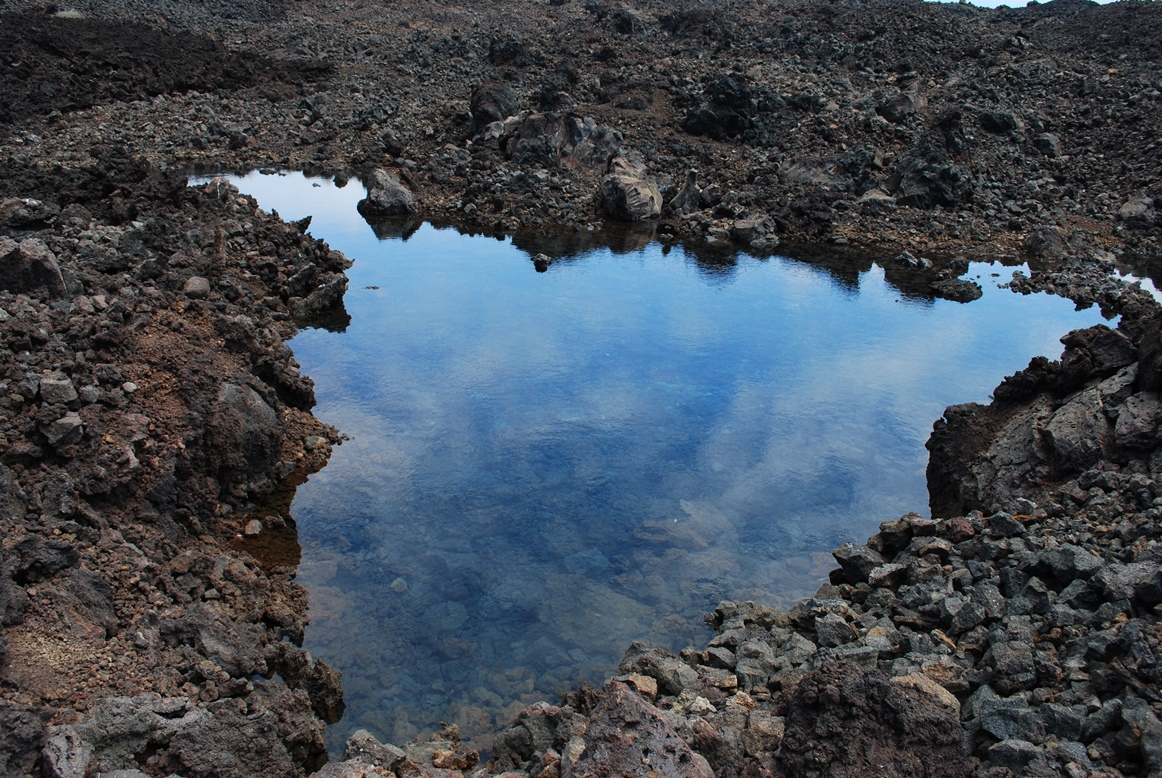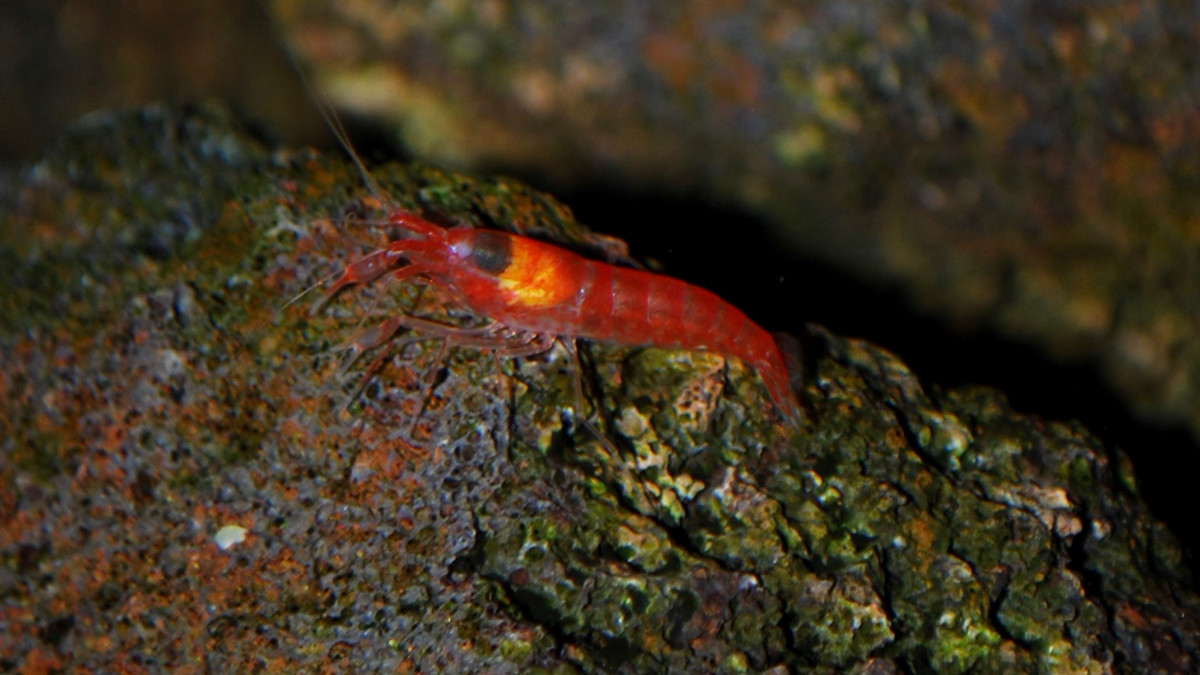PRESERVATION OF ANCHIALINE POOLS, one of the justifications for the successful protection of thousands of acres along the Kaʻū Coast, was the subject of this weekend's International Symposium on Anchialine Ecosystems. It was held Thursday through Saturday at King Kamehameha's Kona Beach Hotel in Kona, drawing more than 125 scientists, students, community members, and resource managers, from across Hawai‘i and around the world. This was the fifth International Symposium on Anchialine Ecosystems.
One sponsor is Hawai'i Wildlife Fund and its president Megan Lamson, who works with volunteers in Kaʻū and beyond on preserving anchialine pools and other coastal resources. Another is The Nature Conservancy, with its Hawai'i Island headquarters based in Kaʻū. A major sponsor is state Department of Land & Natural Resources Division of Aquatic Resources.
The human gathering about anchialine pools was grounded in the importance of the collective kuleana to culture and place. Hawai‘i has one of the highest concentrations of brackish water, near-coast anchialine pools in the world, with an estimated 600 or more on Hawai‘i Island, said Troy Troy Sakihara. An aquatic biologist with Division of Aquatic Resources, Sakihara is another one of the organizers of the symposium.
He and other presenters noted that anchialine pools were the first sources of fresh water for early Hawaiians, giving the pools great cultural significance, continuing into modern times. This was highlighted in many of the scientific presentations, including one by a trio of students from a Hawaiian immersion school at Keaukaha who presented their remarks entirely in ʻŌlelo Hawai‘i, the Hawaiian language.
"Like so many of Hawai‘i’s natural and cultural resources, anchialine ecosystems have already been destroyed or are threatened by development, pollution, and invasive species; in the case of the pools by invasive fish like guppies and tilapia," said the statement from the state Division of Aquatic Resources.
The best-known of the native inhabitants of anchialine pools is the ‘ōpae‘ula, a tiny red shrimp.
 |
A wai ‘ōpae (water for shrimp) in an ‘a‘a lava field. These pools are home to tiny endangered native shrimp. Photo from DLNR |
The best-known of the native inhabitants of anchialine pools is the ‘ōpae‘ula, a tiny red shrimp.
Several of the presentations focused on water quality in the park’s anchialine pools and the use of ‘auhuhu, a Polynesian introduced plant to control invasive fish and the associated recovery of the natural ecosystem.
Sakihara said that a broad partnership in preserving anchialine pools “demonstrates how important this underground system of pools is and why we need to do everything we can to protect and restore them.”
The symposium was heavy on science, but with the overall message that anchialine ecosystems continue to be an important and vital connection to Hawai'i's natural and cultural landscape and history.
In addition to Department of Aquatic Resources, Hawai'i Wildlife Fund and The Nature Conservancy, other sponsors and contributors to the symposium include, Division of Forestry & Wildlife, the Division of State Parks, Hui Loko, University of Hawai‘i, U.S. Fish & Wildlife Service, Kamehameha Schools, U.S. Geological Survey, Lili‘uokalani Trust, He‘eia Bay Forever, Hawai‘i Fish Habitat Partnership, Hawai‘i Mountain Running, National Park Service, Kua’aina Ulu ‘Auamo, Hawai‘i Coral Reef Initiative, David Shepard Hawai‘i, Mauna Lani Auberge Resorts, and Four Seasons Resort.
The symposium was heavy on science, but with the overall message that anchialine ecosystems continue to be an important and vital connection to Hawai'i's natural and cultural landscape and history.
In addition to Department of Aquatic Resources, Hawai'i Wildlife Fund and The Nature Conservancy, other sponsors and contributors to the symposium include, Division of Forestry & Wildlife, the Division of State Parks, Hui Loko, University of Hawai‘i, U.S. Fish & Wildlife Service, Kamehameha Schools, U.S. Geological Survey, Lili‘uokalani Trust, He‘eia Bay Forever, Hawai‘i Fish Habitat Partnership, Hawai‘i Mountain Running, National Park Service, Kua’aina Ulu ‘Auamo, Hawai‘i Coral Reef Initiative, David Shepard Hawai‘i, Mauna Lani Auberge Resorts, and Four Seasons Resort.
To read comments, add your own, and like this story, see www.facebook.com/kaucalendar. See latest print edition at wwwkaucalendar.com. See upcoming events at https://kaunewsbriefs.blogspot.com/2022/04/upcoming-events-for-kau-and-volcano.html.
"All levels of the organization’s services including hospice, palliative, and bereavement care services will continue to be provided for our East Hawai'i Community in various locations other than PMCC, like patient residences, long-term care facilities, and more," said the statement from Hawai'i Care Choices, formerly Hospice of Hilo.
DEADLINE TO REACTIVATE DRIVER'S LICENSES that were given an extension during the pandemic is Nov. 30. Licenses that expired between March 16, 2020 and Nov. 30, 2021 were given the extension. A statement from the county says, "If a driver's license expired within this time period the driver must go in to a County Driver's Licensing Office to reactivate and renew their driver's license by the close of business on Nov. 30, 2022. On Dec 1, 2022, all drivers holding a license that expired from March 16, 2020 through Nov. 30, 2021 will be required to start again as a new applicant."
"The tactical pause, which is a deliberate break in operations, will allow time for Hawai'i Care Choices to reassess the impact of continued underutilization and the growing cost of building repair and maintenance that is naturally occurring after ten years of usage." CEO Brenda S. Ho said, “This tactical pause offers the necessary break to reimagine and discover possible options for this beautiful home-like facility.”
The statement said "data and trends over the years show that patients prefer to receive care in the comfort of their own homes."
The statement said "data and trends over the years show that patients prefer to receive care in the comfort of their own homes."
Board President Karen Maedo said, “We touched many lives at Pohai Malama, but resources are limited and change has to be made when it is needed.” Fewer that 5 percent of Hawai'i Care Choice’s hospice patient days are in PMCC; most of the organization’s services are delivered to patient’s residence. Medical Director Dr. Lynda Dolan said, “We have always delivered hospice care to where patients lived. This includes the nearly two decades prior to the time PMCC was built. This pause does not change our capability in ensuring quality care is provided.”
Hawai'i Care Choices remains open and continues to offer all services. The highest priority is to minimize the impact of this tactical pause on current patients receiving inpatient hospice care at PMCC. Staff will work with these patients and families to ensure a smooth transition to other locations for hospice care. For any questions, contact Hawai'i Care Choices at 808-969-1733 or care@hawaiicarechoices.org.
Hawai'i Care Choices remains open and continues to offer all services. The highest priority is to minimize the impact of this tactical pause on current patients receiving inpatient hospice care at PMCC. Staff will work with these patients and families to ensure a smooth transition to other locations for hospice care. For any questions, contact Hawai'i Care Choices at 808-969-1733 or care@hawaiicarechoices.org.
For more see www.hawaiicarechoices.org. For care west of South Point, see www.hospiceofkona.org.
To read comments, add your own, and like this story, see www.facebook.com/kaucalendar. See latest print edition at wwwkaucalendar.com. See upcoming events at https://kaunewsbriefs.blogspot.com/2022/04/upcoming-events-for-kau-and-volcano.html.
To read comments, add your own, and like this story, see www.facebook.com/kaucalendar. See latest print edition at wwwkaucalendar.com. See upcoming events at https://kaunewsbriefs.blogspot.com/2022/04/upcoming-events-for-kau-and-volcano.html









